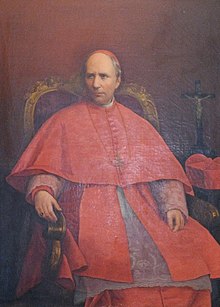Paul Cullen
Paul Cullen ( Irish to Cairdinéal Pól Ó Cuilinn , born April 29, 1803 in Prospect, County Kildare , † October 24, 1878 in Dublin ) was Roman Catholic Archbishop of Armagh and Dublin in Ireland . He was the first cardinal from Ireland and shaped Irish Catholicism in a lasting way .
Life
From the pupil to the principal
Cullen had his first school days in the village school of Ballytore, around 1816 to transfer to the college. At the age of 17 he was called to the Congregation for the Evangelization of Peoples (Congregatio de Propaganda Fide) in 1820 , where the future Pope Leo XIII. as an educated and inquisitive priest . During his education, Paul Cullen acquired a profound knowledge of the classical and oriental languages, which earned him a high reputation. He received his doctorate and was appointed director of the Irish College in Rome in 1832 .
Rector time
His time on the rector's chair (1832-1850) he used for a standard edition of the Greek and Latin lexicon of Hedericus , which is still fully valid today. During this time at university he also gained great confidence in Popes Gregory XVI. and Pius IX. It is to his credit that the Irish College achieved a high academic reputation. In addition, he also took over the leadership of the Congregation for the Evangelization of Peoples , which, however, was temporarily closed due to the political upheavals in Italy, as it was to be taken over by the Italian government.
Archbishop of Armagh, Dublin and Cardinal

St. Mary's Pro-Cathedral, Dublin
Pope Pius IX appointed the then rector of the Irish College in Rome on December 19, 1849 Archbishop of Armagh . The episcopal ordination donated to him on February 24, 1850 in the church of Sant'Agata dei Goti in Rome Castruccio Castracane degli Antelminelli , Cardinal Bishop of Palestrina ; Co-consecrators were Archbishop Carlo Luigi Morichini and John Thomas Hynes , Apostolic Administrator of Demerara . Cullen worked at the same time for almost another year in the Congregatio de Propaganda Fide .
On May 1, 1852, he took over the office of archbishop in Dublin , Pope Pius IX. commissioned him in 1854 as apostolic delegate for the newly established Catholic University of Ireland . In the consistory of June 22, 1866 he was by Pope Pius IX. elevated to cardinal priest of San Pietro in Montorio , making him the first Irish cardinal. During his tenure he presided over two Irish Synods (1850 and 1875) and brought the Irish Church together into a single unit.
Work in rome
During his frequent visits to Rome, he generally stayed at the Irish College, and his statements and analyzes had a great influence on the definition of the dogma of the Immaculate Conception of Mary . His knowledge was from Pope Pius IX. highly valued and he sometimes made use of his theological presentations.
The Church in Ireland and His Successor
The condition of the Catholic Church in Ireland had changed and improved significantly during his episcopate . Those 28 years marked a continuous period of progress in all matters related to religion, discipline, education, and charity. Cardinal Paul Cullen consecrated the priest Edward McCabe as titular bishop of Gadara in 1877 , from which time McCabe was his assistant and was also his successor.
His nephew Patrick Francis Moran , whom he ordained bishop in 1872, later became Archbishop of Sydney and in 1885 the first cardinal from Australia .
literature
- Patrick Francis Moran : Paul Cullen . In: Catholic Encyclopedia , Volume 4, Robert Appleton Company, New York 1908.
Web links
- Cullen, Paul. In: Salvador Miranda : The Cardinals of the Holy Roman Church. ( Florida International University website), accessed November 29, 2016.
- Entry on Paul Cullen on catholic-hierarchy.org ; accessed on August 22, 2016.
- Congregation for the Evangelization of Peoples
Individual evidence
- ^ Fintan Cullen: Visualizing Ireland's first cardinal . In: Dáire Keogh, Albert McDonnell (Ed.): Cardinal Paul Cullen and his World . Four Courts Press, Dublin 2011, ISBN 978-1-84682-235-3 , pp. 401-413 .
| predecessor | Office | successor |
|---|---|---|
| Daniel Murray |
Archbishop of Dublin 1852–1878 |
Edward McCabe |
| William Crolly |
Archbishop of Armagh 1850-1852 |
Joseph Dixon |
| personal data | |
|---|---|
| SURNAME | Cullen, Paul |
| ALTERNATIVE NAMES | Cullen, Paul Cardinal |
| BRIEF DESCRIPTION | Irish cardinal |
| DATE OF BIRTH | April 29, 1803 |
| PLACE OF BIRTH | Prospect, County Kildare |
| DATE OF DEATH | October 24, 1878 |
| Place of death | Dublin |
